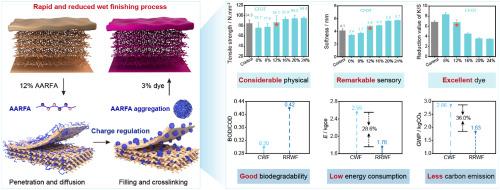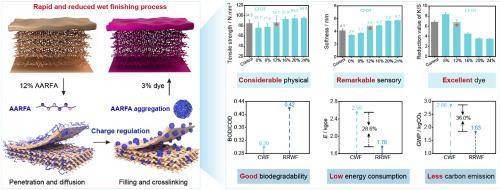面向节能减排的生态皮革生产中快速减量湿整理工艺的两性丙烯酸聚合物工程设计
IF 4.5
2区 化学
Q2 POLYMER SCIENCE
引用次数: 0
摘要
两性聚合物作为皮革复鞣剂,可有效解决无铬鞣革与普通阴离子湿整理材料之间的电荷不平衡问题,提高成品皮革的质量。然而,目前无铬鞣制的化学药剂用量大,湿法精加工工序繁琐,必然导致高污染排放和高能耗。本文通过自由基聚合制备了具有复鞣和加脂功能的两性丙烯酸聚合物(即AARFA),该聚合物具有宽分子量(10 ~ 100 kDa)和合适的粒径(~ 200 nm)。分子动力学模拟和实验表明,AARFA在水中具有良好的分散性,其聚集行为可以通过调节ph来调节。然后,我们将AARFA应用于两种典型的无铬鞣革的快速减湿整理工艺(RRWF)。与传统湿整理工艺(即10%复鞣剂和10%加脂剂)相比,12% AARFA使皮革的胶原纤维分散,物理和感官性能得到改善,染色性能优良。RRWF工艺可以有效地节省工作时间约31%,减少化学品消耗约35%,并具有更好的废水可降解性。我们开发的RRWF工艺为低能耗、低碳排放的无铬皮革制造提供了希望。本文章由计算机程序翻译,如有差异,请以英文原文为准。


Engineering design of amphoteric acrylic polymer for rapid and reduced wet-finishing process of eco-leather production towards energy saving and carbon reduction
Amphoteric polymers as leather retanning agents are considered to effectively address the charge imbalance between chrome-free tanned leather and common anionic wet finishing materials, and improve the quality of finished leather. However, the currently existed high chemical dosage and tedious wet finishing process associated with chrome-free tanning inevitably lead to high pollution emission and energy consumption. Herein, an amphoteric acrylic polymer (i.e., AARFA) with retanning and fatliquoring functions was prepared by free radical polymerization, which exhibited broad molecular weight (10−100 kDa) and appropriate particle size (∼200 nm). Molecular dynamics simulations and experiments showed that AARFA exhibited good dispersion in water and its aggregation behavior can be modulated by adjusting pH. We then applied AARFA in the rapid and reduced wet finishing process (RRWF) for two kinds of typical chrome-free tanned leather. Compared with conventional wet finishing (CWF) process (i.e., 10 % retanning agents and 10 % fatliquor), 12 % AARFA afforded leather dispersed collagen fibers, improved physical and sensory properties, and excellent dyeing performance. The RRWF process can effectively save work time by ∼31 %, reduce chemical consumption by ∼35 % and exhibit better wastewater degradability. Our developed RRWF process offer the promise for the chrome-free leather manufacturing towards low energy consumption and less carbon emissions.
求助全文
通过发布文献求助,成功后即可免费获取论文全文。
去求助
来源期刊

Polymer
化学-高分子科学
CiteScore
7.90
自引率
8.70%
发文量
959
审稿时长
32 days
期刊介绍:
Polymer is an interdisciplinary journal dedicated to publishing innovative and significant advances in Polymer Physics, Chemistry and Technology. We welcome submissions on polymer hybrids, nanocomposites, characterisation and self-assembly. Polymer also publishes work on the technological application of polymers in energy and optoelectronics.
The main scope is covered but not limited to the following core areas:
Polymer Materials
Nanocomposites and hybrid nanomaterials
Polymer blends, films, fibres, networks and porous materials
Physical Characterization
Characterisation, modelling and simulation* of molecular and materials properties in bulk, solution, and thin films
Polymer Engineering
Advanced multiscale processing methods
Polymer Synthesis, Modification and Self-assembly
Including designer polymer architectures, mechanisms and kinetics, and supramolecular polymerization
Technological Applications
Polymers for energy generation and storage
Polymer membranes for separation technology
Polymers for opto- and microelectronics.
 求助内容:
求助内容: 应助结果提醒方式:
应助结果提醒方式:


